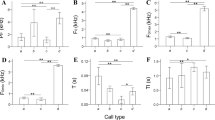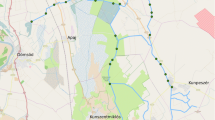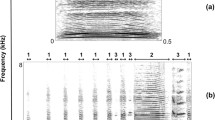Abstract
Saiga antelopes Saiga tatarica tatarica give birth in large aggregations, and offspring follow the herd soon after birth. Herding is advantageous as anti-predator strategy; however, communication between mothers and neonates is strongly complicated in large aggregations. Individual series of nasal and oral contact calls of mother and neonate saiga antelopes were selected from recordings made with automated recording systems placed near the hiding neonates on the saiga breeding grounds in Northern Kazakhstan during synchronized parturitions of 30,000 calving females. We used for comparison of the acoustic structure of nasal and oral contact calls 168 nasal calls of 18 mothers, 192 oral calls of 21 mothers, 78 nasal calls of 16 neonates, and 197 oral calls of 22 neonates. In the oral calls of either mothers or neonates, formant frequencies were higher and the duration was longer than in the nasal calls, whereas fundamental frequencies did not differ between oral and nasal calls. Discriminant function analysis (DFA) based on six acoustic variables, accurately classified individual identity for 99.4% of oral calls of 18 mothers, for 89.3% of nasal calls of 18 mothers, and for 94.4% of oral calls of 18 neonates. The average value of correct classification to individual was higher in mother oral than in mother nasal calls and in mother oral calls than in neonate oral calls; no significant difference was observed between mother nasal and neonate oral calls. Variables mainly responsible for vocal identity were the fundamental frequency and the second and third formants in either mothers or neonates, and in either nasal or oral calls. The high vocal identity of mothers and neonates suggests a powerful potential for the mutual mother-offspring recognition in dense aggregations of saiga antelopes as an important component of their survival strategy.




Similar content being viewed by others
References
Aubin T, Jouventin P (1998) Cocktail-party effect in king penguin colonies. Proc R Soc Lond B 265:1665–1673
Bannikov AG, Jirnov LV, Lebedeva LS, Fandeev AA (1961) Saiga biology. Agricultural Literature Press, Moscow [in Russian]
Baotic A, Sicks F, Stoeger AS (2015) Nocturnal “humming” vocalizations: adding a piece to the puzzle of giraffe vocal communication. BMC Research Notes 8:425. doi:10.1186/s13104-015-1394-3
Bekenov AB, Grachev I. A, Milner-Gulland EJ (1998) The ecology and management of the saiga antelope in Kazakhstan. Mammal Rev 28:1–52
Blank DA (1998) Mating behavior of the Persian gazelle Gazella subgutturosa Güldenstaedt, 1780. Mammalia 62:499–519
Blank DA, Ruckstuhl K, Yang W (2015) Antipredator strategy of female goitered gazelles (Gazella subgutturosa Guld., 1780) with hiding fawn. Behav Process 119:44–49
Bonar M, Manseau M, Geisheimer J, Bannatyne T, Lingle S (2016) The effect of terrain and female density on survival of neonatal white-tailed deer and mule deer fawns. Ecol Evol. doi:10.1002/ece3.2178
Brandlová K, Bartoš L, Haberová T (2013) Camel calves as opportunistic milk thefts? The first description of allosuckling in domestic bactrian camel (Camelus bactrianus). PLoS One 8(1):e53052. doi:10.1371/journal.pone.0053052
Briefer E, McElligott AG (2011a) Mutual mother–offspring vocal recognition in an ungulate hider species (Capra hircus). Anim Cogn 14:585–598
Briefer EF, McElligott AG (2011b) Indicators of age, body size and sex in goat kid calls revealed using the source–filter theory. Appl Anim Behav Sci 133:175–185
Briefer EF, Padilla de la Torre MP, McElligott AG (2012) Mother goats do not forget their kids’ calls. Proc R Soc B 279:3749–3755
Buuveibaatar B, Fuller TK, Fine AE, Chimeddorj B, Young JK, Berger J (2013a) Changes in grouping patterns of saiga antelope in relation to intrinsic and environmental factors in Mongolia. J Zool 291:51–58
Buuveibaatar B, Young JK, Berger J, Fine AE, Lkhagvasuren B, Zahler P, Fuller TK (2013b) Factors affecting survival and cause-specific mortality of saiga calves in Mongolia. J Mammal 94:127–136
Charrier I, Mathevon N, Jouventin P (2002) How does a fur seal mother recognize the voice of her pup? An experimental study of Arctocephalus tropicalis. J Exp Biol 205:603–612
Charrier I, Aubin T, Mathevon N (2010) Mother-calf vocal communication in Atlantic walrus: a first field experimental study. Anim Cogn 13:471–482
Danilkin AA (2005) Hollow-horned ruminants (Bovidae). KMK Scientific Press, Moscow [in Russian]
Development Core Team R (2012) R: a language and environment for statistical computing. R Foundation for Statistical Computing, Vienna http://www.R-project.org/
Dillon WR, Goldstein M (1984) Multivariate analysis: methods and applications. Wiley, New York
Efremova KO, Volodin IA, Volodina EV, Frey R, Lapshina EN, Soldatova NV (2011) Developmental changes of nasal and oral calls in the goitred gazelle Gazella subgutturosa, a nonhuman mammal with a sexually dimorphic and descended larynx. Naturwissenschaften 98:919–931
Efremova KO, Frey R, Volodin IA, Fritsch G, Soldatova NV, Volodina EV (2016) The postnatal ontogeny of the sexually dimorphic vocal apparatus in goitred gazelles (Gazella subgutturosa). J Morphol 277:826–844
Espmark Y (1971) Individual recognition by voice in reindeer mother-young relationship. Behaviour 40:295–301
Espmark Y (1975) Individual characteristics in the calls of reindeer calves. Behaviour 54:50–59
Fadeev VA, Sludskii AA (1982) Saiga in Kazakhstan. Academy of Sciences Press, Alma-Ata [in Russian]
Fisher DO, Blomberg SP, Owens PF (2002) Convergent maternal care strategies in ungulates and macropods. Evolution 56:167–176
Fitch WT, Reby D (2001) The descended larynx is not uniquely human. Proc R Soc B 268:1669–1675
Frey R, Volodin I, Volodina E (2007) A nose that roars: anatomical specializations and behavioural features of rutting male saiga. J Anat 211:717–736
Jacques CN, Jenks JA (2010) Antipredatory defense of neonatal pronghorn (Antilocapra americana) by yearling male pronghorn in Southwestern South Dakota. West N Am Nat 70:570–572
Jevnerov VV (1984) Goitred gazelles of Barsakelmes Island. Nauka, Alma-Ata [in Russian]
Kjellander P, Svartholm I, Bergvall UA, Jarnemo A (2012) Habitat use, bed-site selection and mortality rate in neonate fallow deer Dama dama. Wildl Biol 18:280–291
Kock RA, Orynbayev MB, Sultankulova KT, Strochkov VM, Omarova ZD, Shalgynbayev EK, Rametov NM, Sansyzbay AR, Parida S (2015) Detection and genetic characterization of lineage IV Peste Des Petits ruminant virus in Kazakhstan. Transbound Emerg Dis 62:470–479
Kokshunova L (2012) Ecology and behaviour of the saiga antelope (Saiga tatarica tatarica L., 1766) in conditions of extreme anthropogenic pressure. Lambert Academic Publishing, Saarbrücken [in Russian]
Kühl A, Mysterud A, Erdnenov G, Lushchekina AA, Grachev IA, Bekenov AB, Milner-Gulland EJ (2007) The “big spenders” of the steppe: sex-specific maternal allocation and twinning in the saiga antelope. Proc R Soc B 274:1293–1299
Kühl A, Mysterud A, Grachev IA, Bekenov AB, Ubushaev BS, Lushchekina AA, Milner-Gulland EJ (2009) Monitoring population productivity in the saiga antelope. Anim Conserv 12:355–363
Lent PC (1974) Mother-infant relationships in ungulates. In: Geist V, Walther F (eds) Behaviour of ungulates and its relation to management, New Series 24. IUCN. IUCN Publications, Morges, pp 14–55
Lingle S, Rendall D, Pellis SM (2007a) Altruism and recognition in the antipredator defence of deer: 1. Species and individual variation in fawn distress calls. Anim Behav 73:897–905
Lingle S, Rendall D, Wilson WF, Deyoung RW, Pellis SM (2007b) Altruism and recognition in the antipredator defence of deer: 2. Why mule deer help nonoffspring fawns. Anim Behav 73:907–916
Lingle S, Wyman MT, Kotrba R, Teichroeb LJ, Romanow CA (2012) What makes a cry a cry? A review of infant distress vocalizations. Curr Zool 58:698–726
Llusia D, Marquez R, Bowker R (2011) Terrestrial sound monitoring systems, a methodology for quantitative calibration. Bioacoustics 20:277–286
Matrosova VA, Volodin IA, Volodina EV, Babitsky AF (2007) Pups crying bass: vocal adaptation for avoidance of age-dependent predation risk in ground squirrels? Behav Ecol Sociobiol 62:181–191
Matrosova VA, Volodin IA, Volodina EV (2009) Short-term and long-term individuality in speckled ground squirrel alarm calls. J Mammal 90:158–166
Matrosova VA, Volodin IA, Volodina EV, Vasilieva NA (2010) Stability of acoustic individuality in the alarm calls of wild yellow ground squirrels Spermophilus fulvus and contrasting calls from trapped and free-ranging callers. Naturwissenschaften 97:707–715
Milner-Gulland EJ, Kholodova MV, Bekenov A, Bukreeva OM, Grachev IA, Amgalan L, Lushchekina AA (2001) Dramatic declines in saiga antelope populations. Oryx 35:340–345
Nowak R, Porter R, Lévy F, Orgeur P, Schaal B (2000) Role of mother-young interactions in the survival of offspring in domestic mammals. Rev Reprod 5:153–163
Obrist MK, Pavan G, Sueur J, Riede K, Llusia D, Marquez R (2010) Bioacoustics approaches in biodiversity inventories. In: Eymann J, Degreef J, Häuser C, Monje JC, Samyn Y, Vanden Spiegel D (eds) Manual on field recording techniques and protocols for all taxa biodiversity inventories and monitoring. V. 8. Part 1. Abc Taxa, Brussels, pp 68–99
Orynbayev MB, Beauvais W, Sansyzbay AR, Rystaeva RA, Sultankulova KT, Kerimbaev AA, Kospanova MN, Kock RA (2016) Seroprevalence of infectious diseases in saiga antelope (Saiga tatarica tatarica) in Kazakhstan 2012–2014. Prevent Vet Med 127:100–104
Padilla de la Torre M, Briefer EF, Ochocki BM, McElligott AG, Reader T (2016) Mother-offspring recognition via contact calls in cattle, Bos taurus. Anim Behav 114:147–154
Pitcher BJ, Harcourt RG, Charrier I (2010) Rapid onset of maternal vocal recognition in a colonially breeding mammal, the Australian sea lion. PLoS One 5(8):e12195. doi:10.1371/journal.pone.0012195
Ralls K, Kranz K, Lundrigan B (1986) Mother-offspring relationships in captive ungulates: variability and clustering. Anim Behav 34:134–145
Reby D, McComb K (2003) Anatomical constraints generate honesty: acoustic cues to age and weight in the roars of red deer stags. Anim Behav 65:519–530
Roberts BA, Rubenstein DI (2014) Maternal tactics for mitigating neonate predation risk during the postpartum period in Thomson’s gazelle. Behavior 151:1229–1248
Scornavacca D, Brunetti C (2016) Cooperative defence of female chamois successfully deters an eagle attack. Mammalia 80:453–456
Sèbe F, Nowak R, Poindron P, Aubin T (2007) Establishment of vocal communication and discrimination between ewes and their lamb in the first two days after parturition. Dev Psychobiol 49:375–386
Sèbe F, Duboscq J, Aubin T, Ligout S, Poindron P (2010) Early vocal recognition of mother by lambs: contribution of low- and high-frequency vocalizations. Anim Behav 79:1055–1066
Shillito-Walser EE, Hague P, Walters E (1981) Vocal recognition of recorded lambs’ voices by ewes of three breeds of sheep. Behaviour 78:260–272
Sibiryakova OV, Volodin IA, Matrosova VA, Volodina EV, Garcia AJ, Gallego L, Landete-Castillejos T (2015) The power of oral and nasal calls to discriminate individual mothers and offspring in red deer, Cervus elaphus. Front Zool 12:2. doi:10.1186/s12983-014-0094-5
Singh NJ, Grachev IA, Bekenov AB, Milner-Gulland EJ (2010) Saiga antelope calving site selection is increasingly driven by human disturbance. Biol Conserv 143:1770–1779
Smith WP (1987) Maternal defense in Columbian white-tailed deer: when is it worth it? Am Nat 130:310–316
Sokolov VE, Zhirnov LV (1998) The Saiga antelope. Phylogeny, systematic, ecology, conservation and use. Russian Academy of Sciences, Moscow [in Russian]
Solow AR (1990) A randomization test for misclassification probability in discriminant analysis. Ecology 71:2379–2382
Stoeger AS, Heilmann G, Zeppelzauer M, Ganswindt A, Hensman S, Charlton BD (2012) Visualizing sound emission of elephant vocalizations: evidence for two rumble production types. PLoS One 7(11):e48907. doi:10.1371/journal.pone.0048907
Swan DC, Hare JF (2008) Signaler and receiver ages do not affect responses to Richardson’s ground squirrel alarm calls. J Mammal 89:889–894
Taylor AM, Reby D (2010) The contribution of source–filter theory to mammal vocal communication research. J Zool 280:221–236
Terrazas A, Serafin N, Hernandez H, Nowak R, Poindron P (2003) Early recognition of newborn goat kids by their mother: II. Auditory recognition and evidence of an individual acoustic signature in the neonate. Dev Psychobiol 43:311–320
Torriani MVG, Vannoni E, McElligott AG (2006) Mother-young recognition in an ungulate hider species: a unidirectional process. Am Nat 168:412–420
Vaňková D, Málek J (1997) Characteristics of the vocalizations of red deer Cervus elaphus hinds and calves. Bioacoustics 7:281–289
Vaňková D, Bartoš L, Málek J (1997) The role of vocalization in the communication between red deer hinds and calves. Ethology 103:795–808
Volodin IA, Volodina EV, Efremova KO (2009) Antelope, calling through the nose: structure of sounds and effect of sexual selection on the vocal behavior of the saiga (Saiga tatarica). Zool Zh 88:113–124 [in Russian]
Volodin IA, Lapshina EN, Volodina EV, Frey R, Soldatova NV (2011) Nasal and oral calls in juvenile goitred gazelles (Gazella subgutturosa) and their potential to encode sex and identity. Ethology 117:294–308
Volodin IA, Volodina EV, Frey R, Maymanakova IL (2013) Vocal activity and acoustic structure of the rutting calls of Siberian wapiti (Cervus elaphus sibiricus) and their imitation with a hunting luring instrument. Russian J Theriol 12:99–106
Volodin IA, Sibiryakova OV, Kokshunova LE, Frey R, Volodina EV (2014) Nasal and oral calls in mother and young trunk-nosed saiga antelopes, Saiga tatarica. Bioacoustics 23:79–98
Volodin IA, Matrosova VA, Volodina EV, Garcia AJ, Gallego L, Márquez R, Llusia D, Beltrán JF, Landete-Castillejos T (2015a) Sex and age-class differences in calls of Iberian red deer during rut: reversed sex dimorphism of pitch and contrasting roars from farmed and wild stags. Acta Ethol 18:19–29
Volodin IA, Volodina EV, Sibiryakova OV, Naidenko SV, Hernandez-Blanco JA, Litvinov MN, Rozhnov VV (2015b) Vocal activity of the red deer and the acoustic structure of its rutting calls in the Russian Far East. Dokl Biol Sci 462:144–147
Volodin IA, Zaytseva AS, Ilchenko OG, Volodina EV (2015c) Small mammals ignore common rules: a comparison of vocal repertoires and the acoustics between pup and adult piebald shrews Diplomesodon pulchellum. Ethology 121:103–115
Volodin IA, Sibiryakova OV, Volodina EV (2016a) Sex and age-class differences in calls of Siberian wapiti Cervus elaphus sibiricus. Mammal Biol 81:10–20
Volodin IA, Volodina EV, Golosova OS (2016b) Automated monitoring of vocal rutting activity in red deer (Cervus elaphus). Russian J Theriol 15:91–99
Volodina EV, Matrosova VA, Volodin IA (2010) An unusual effect of maturation on the alarm call fundamental frequency in two species of ground squirrels. Bioacoustics 20:87–98
Weary DM, Chua B (2000) Effects of early separation on the dairy cow and calf: 1. Separation at 6 h, 1 day and 4 days after birth. Appl Anim Behav Sci 69:177–188
Acknowledgements
We thank Natalia Soldatova and the staff of the Association for the Conservation of Biodiversity of Kazakhstan for their advice and support. We thank the two anonymous reviewers for their valuable suggestions how to improve the manuscript.
Author information
Authors and Affiliations
Corresponding author
Ethics declarations
Ethical approval
All applicable international, national, and institutional guidelines for the care and use of animals were followed. All audio recordings and weighing of animals were conducted in tight cooperation with authorized bodies of Kazakhstan (Association for the Conservation of the Biodiversity of Kazakhstan) during the species censuses and conservation measures. During our work, we strictly adhered to the special welfare instructions developed by the authorized bodies for work with saigas. The data collection protocol # 2011-36 was approved by the Committee of Bio-ethics of Lomonosov Moscow State University.
Conflicts of interest
The authors declare that they have no conflict of interest.
Informed consent
Informed consent was not required.
Funding
The study was supported by the Russian Foundation for Basic Research, grants 15-04-06241 (for IAV and EVV) and 16-34-01230 (for OVS).
Additional information
Communicated by: Sven Thatje
Electronic supplementary material
Rights and permissions
About this article
Cite this article
Sibiryakova, O.V., Volodin, I.A., Frey, R. et al. Remarkable vocal identity in wild-living mother and neonate saiga antelopes: a specialization for breeding in huge aggregations?. Sci Nat 104, 11 (2017). https://doi.org/10.1007/s00114-017-1433-0
Received:
Revised:
Accepted:
Published:
DOI: https://doi.org/10.1007/s00114-017-1433-0




